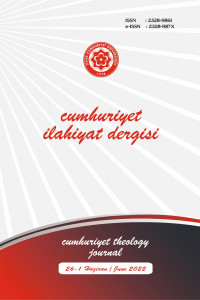Seyyid Muhammed Ali Rıza’nın Gencü’l-Esrâr’ındaki Cennet Tasviri
The Description of Paradise in Sayyid Muḥammad ʿAlī Rıḍā’s Genc al-Esrār
Author(s): Duygu Kayalik ŞahinSubject(s): Islam studies, Turkish Literature, Interwar Period (1920 - 1939), Translation Studies
Published by: Cumhuriyet Üniversitesi İlahyat Fakültesi
Keywords: Turkish-Islamic Literature; Genc al-Esrār; Sayyid Muḥammad ʿAlī Rıḍā from Ġāzīantep; Paradise; Description;
Summary/Abstract: In Turkish-Islamic literature, many copyright or translation naṣīḥat-nāma with religious-mystical content have been written. In these works written in verse or prose form, information about the principles of Islamic belief and worship is given; people are advised to be moral, faithful, observant of the orders and prohibitions of religion, prioritizing the ḥadīths of the Prophet, benevolent and tolerant. One of these naṣīḥat-nāmas is Genc al-Esrār, in which verses consisting of different verse forms are connected to each other with instrumental couplets. As can be understood from the types and contents of the works he copyrighted, Sayyid Muḥammad ʿAlī Rıḍā from Ġāzīantep, a sufi poet, was affiliated with Shaykh ʿOthmān ʿAvnī Bābā from ʿUrfā, one of the caliphs of the Khāliṣiyya branch of the Qādirī sect, and Shaykh Mustafa Bābā from Ġāzīantep, who was his caliph. In Genc al-Esrār, which was written on 22 Rebiülahir (Rabī II) 1342/December 2, 1923, the concept of heaven was discussed from various aspects. The poet who uses the Esrārī pseudonym in the poem, sometimes by quoting verses and ḥadīths, he used argument and proof to make his word trustworthy, sometimes by embellishing his personal imagination of heaven with the opportunity provided by literary arts, he depicted and narrated the lofty place that the reader would like to reach. After integrating the imagination of the poet with the description, it was narrated, and an effect on the reader was tried to be achieved with the atmosphere created by the story. In these sections, where the narration comes to the fore, Muḥammad ʿAlī Rıḍā presented the concept of heaven, which he created in his own imagination, by blending it with the Qurʾān and ḥadīth. In our study, it is aimed to reveal in which dimensions and forms the notion of heaven is depicted in Genc al-Esrār. For this purpose, first of all, data about the paradise in Genc al-Esrār were determined by using the scanning model, which is one of the research methods. All kinds of information, comments, and narratives that can help us to make an inference about Sayyid Muḥammad ʿAlī Rıḍā’s vision and description of heaven has been studied under four headings: "Physical Description of Paradise", "Description of Names, Types and Doors of Paradise", "Description of the Inhabitants of Paradise" and "Mysterious Expression of His Desire to Reach Paradise". This study, which reveals that heaven is handled in detail and artistically in Genc al-Esrār, which was written in 1923 by adhering to the tradition of dīvān literature, is important in terms of shedding light on the existence of Islamic literature in the 20th century. As a result of the research, it is seen that Esrārī depicts the physical features of heaven with words, based on the verses and ḥadīth about heaven. Esrārī said that heaven is composed of musq, saffron, qāfūr and ʿamber; he stated that there are vineyards and gardens of unmatched beauty in heaven. Describing countless cities that are a thousand times the size of this world and the thousands of doors, tents, pavilions and cells in these cities, the poet wrote that there is a throne in front of the cells in heaven. He also mentioned that there was a mattress on these thrones and that a funnel was sitting on this mattress. After stating that there are milk, honey, wine and kevser rivers in heaven, Muhammad Ali Rıza, who explained the characteristics of these rivers, also described the selsebil spring with kafir and tesnîm drinks. The poet, who physically described the Burāqs in heaven, narrated their behavior. Esrârî also described the birds of paradise with their various characteristics and stated that there are blessings in paradise that no one can imagine. Stating that a large number of houris, each of which will be 16 years old, will be given to the people of heaven, Esrārī has described the houris physically. He also explained in an exaggerated style the attitude and behavior of the houris towards the people of heaven. It is seen that the poet, who also described and narrated the ġılmān and wildāns in heaven, divided the heaven into two as the ordinary (ʿawām) and elite (khawāṣ). Esrārī mentioned the names of the gates of heaven as Dār al-Celāl, Dār es-Selām, Dār al-Meʾvā, Dâr al-Khuld, Dār al-Firdevs, Dār al-Úarār and Dār al-ʿAdn and wrote down their physical structures. After stating that Ḥasan, Ḥüseyin and ʿÖmer reside in heaven, Esrārī stated that those who love Abū Bakr will reach paradise. He made physical descriptions of the inhabitants of heaven and explained in detail the transfer of people to paradise who passed the aṣ-Ṣırāṭ on the day of judgment. Esrārī stated that on Saturday Adam would have a banquet in the Khuld; on Sunday Süleymān would have a banquet in the Naʿīm, on Monday İbrāhīm would have a banquet in the Firdevs; on Tuesday Mūsā would have a banquet in the Meʾvā; on Wednesday ʿĪsā would have a banquet in the ʿAdn and on Thursday Prophet Muḥammad would have a banquet in the Vesìle. It is seen that Esrārī narrates those who will be honored by ruʾyat Allāh in Dār al-Celāl on Friday.
Journal: Cumhuriyet İlahiyat Dergisi
- Issue Year: 26/2022
- Issue No: 1
- Page Range: 341-363
- Page Count: 24
- Language: Turkish

